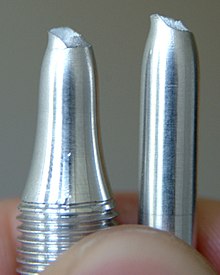Ductility


Ductility (derived from the Latin ducere , dt. Pull) is the property of a material located at, shear stress prior to fracture permanently plastically to deform . Glass has a very low ductility. Therefore it breaks with no noticeable deformation. Structural steel, on the other hand, deforms by more than 25% before cracking. Gold is so ductile that it can be expelled in the form of gold leaf to a thickness of a few atomic layers.
Materials with this property are important in construction, so that a structure “announces” its failure in a clearly visible manner before it collapses if the stresses are too high. Ductile materials are also in demand in the automotive industry, since a car should deform plastically in the event of an accident and not tear apart. In the past, ductility was synonymous with forgeability . Ductile fabrics are easy to cold form, e.g. B. by deep drawing , bending or stretching . Materials that are only slightly ductile could cause injuries from flying parts if they burst.
The opposite of ductility is brittleness .
Overview
In principle, there are two possible processes for the plastic deformation of crystals, i.e. especially for metals with a crystalline structure, after the load has exceeded the yield point. Either they deform in a flexible manner, then they are called ductile , or they deform in a brittle manner and burst, then they are called brittle .
- In geology , the term is used for rocks, especially those of the lower continental crust , which, under tectonic stress, do not become brittle but rather plastically deform.
- When testing bitumen , a sample is clamped in a so-called ductileometer and pulled apart until the bitumen thread that is created breaks. The length of the thread at the time of breaking is called the ductility of the bitumen . In the case of polymer-modified bitumen, the force ductility according to DIN EN 13589 is of interest. The bitumen thread is stretched from 30 mm to 400 mm and the work that was done when stretching from 200 mm to 400 mm is calculated.
Many materials lose their ductility at low temperatures and become brittle. Because of this behavior, many structures (bridges, ships, etc.) have been destroyed.
definition
The ductility can best be defined using a schematic representation. There is shown a crack in a material. A force acts in the normal direction at the top and bottom of the crystal. If the crystal then deforms in that the two monolayers can be easily separated from each other without changing their structure, the material obviously breaks apart and in this sense it is called brittle . If, on the other hand, the crystal deforms as the monolayers slide upwards one after the other, the material flows in this sense and it is referred to as ductile .
Danger from ductility in electrical terminal points
Ductility of the conductor material is undesirable for electrical contact points that are finite mechanically prestressed. Aluminum conductors may be mentioned as an example .
If electrical contact points are soldered with tin solder and mechanical pressure comes into play - for example through a screw connection - the tin content in the tin solder can evade over time, so that the connection becomes loose. This danger exists especially with soldered stranded wires that are screwed into clamp connections . As a result, the pressure of the terminal causes the solder to flow, and the contact resistance at the terminal point increases over time. With high currents, this can lead to the terminal and / or wire insulation melting due to the high power dissipation of the terminal and a cable fire occurring , i.e. H. the electrical connection is thermally destroyed. As a remedy, wire end sleeves should be pressed onto stranded wires and these wire end sleeves screwed into the clamp connection.
literature
- Hansgerd fights: reinforcement technology. Basics - Practice - Examples - Profitability, 1st edition, Vieweg + Teubner Verlag, Wiesbaden 2010, ISBN 978-3-8348-0767-0 .
- Nasser Kanani: Modern measuring and testing methods for metallic and other inorganic coatings. Expert Verlag, Renningen 2007, ISBN 978-3-8169-2653-5 .
Web links
- Influences on the ductility parameters of reinforcing steel (accessed on October 22, 2015)
- Fastener ductility (accessed October 22, 2015)
